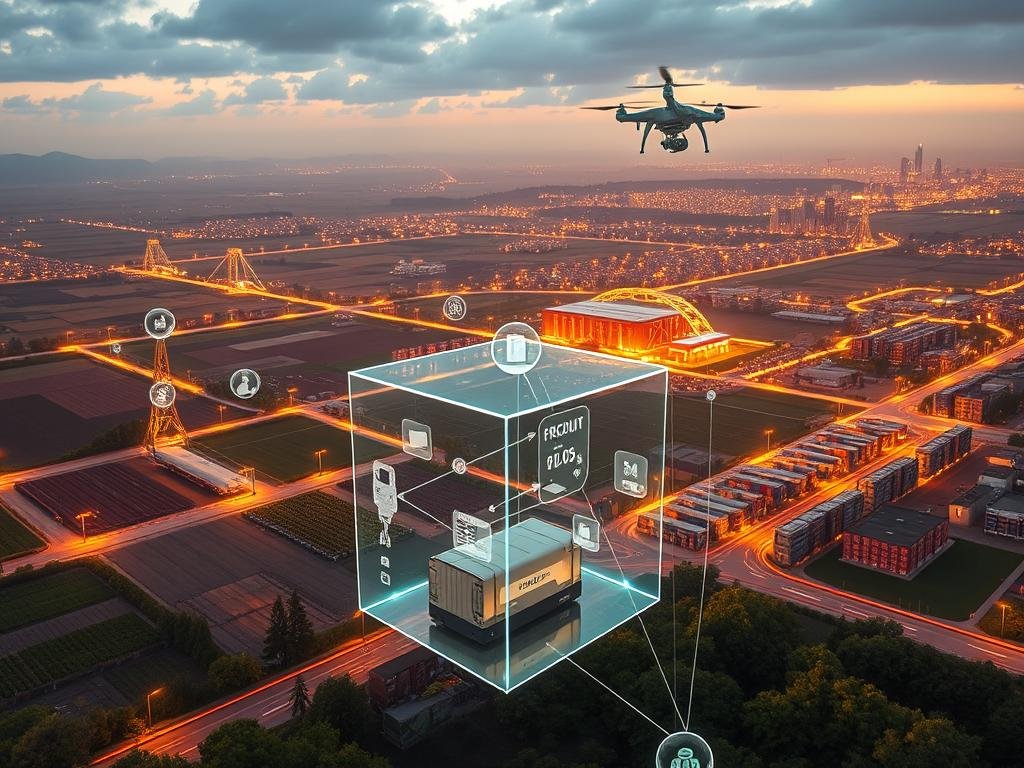Did you know that supply chain inefficiencies could cost businesses over $2 trillion globally by 2025? But, blockchain technology is changing how we track and manage supply chains, mainly in the food industry. It makes sure food is safe, real, and eco-friendly by tracing it from farm to fork.
Big names like Walmart are using blockchain to track food fast, in just seconds. This is a big leap from the old days. It not only makes food safer but also cuts down on the costs of recalls by speeding up the process.
Key Takeaways
- Blockchain technology significantly enhances supply chain traceability.
- Walmart and other major retailers use blockchain to track food shipments rapidly.
- Blockchain adoption can lead to substantial cost savings by reducing inefficiencies.
- Improved traceability ensures safer food products for consumers.
- The use of blockchain can reduce the time taken for contamination investigations.
What is Blockchain Technology?
Blockchain is a decentralized ledger technology that makes transactions secure and clear. It’s used in many fields because it boosts trust, security, and efficiency.
Definition and Key Concepts
Blockchain is a shared ledger that records transactions on a network of computers. It ensures data integrity and transparency. Key ideas include decentralization, immutability, and consensus.
The decentralized nature of blockchain technology means no single entity controls the data. This makes it hard to tamper with or cheat. It’s great for managing digital assets securely.
How Blockchain Works
The process of blockchain involves a network of nodes verifying transactions. These transactions are grouped into blocks, linked by cryptographic hashes. This creates a permanent, unchangeable record.
Think of it like this: each block has transactions, a timestamp, and a link to the previous block. This ensures the integrity and security of the data on the blockchain.
Types of Blockchain
There are different types of blockchain networks. Public blockchains are open to everyone. Private blockchains are only for a specific group.
For more on blockchain and its uses, check out Digital Vista Online. They talk about blockchain’s role in Web3.
The Role of Blockchain in Supply Chain Management
Blockchain is changing the game in supply chain management. It brings more transparency and traceability. With blockchain, your supply chain can be more secure and efficient.
Enhancing Transparency
Blockchain makes supply chains more transparent. It uses a decentralized and unchangeable ledger. This lets everyone see the same information, cutting down on misunderstandings and building trust.
- Real-time tracking and monitoring of goods
- Immutable records of transactions
- Transparent ownership and provenance
Improving Traceability
Blockchain makes it easier to track products in the supply chain. This is key in industries like food and pharmaceuticals, where knowing where goods come from is vital.
Key benefits of improved traceability include:
- Reduced risk of counterfeit products
- Easier identification of supply chain disruptions
- Compliance with regulatory requirements
Reducing Fraud
Blockchain cuts down on fraud in supply chains. It does this by keeping a secure and open record of transactions. This is thanks to advanced cryptography and a network of nodes.

- Authentication of products and transactions
- Prevention of tampering and alteration
- Detection of suspicious activity
Benefits of Using Blockchain in Supply Chains
Businesses can greatly improve their supply chain operations with blockchain. It brings more transparency and reliability. Blockchain technology offers many benefits for managing supply chains.
Increased Efficiency
Blockchain makes supply chains more efficient. It uses a decentralized ledger to automate processes. This reduces the need for manual work and cuts down on errors.
It also allows for real-time tracking of goods. This means companies can quickly handle any problems. It makes the supply chain faster and more reliable, improving customer satisfaction.
Cost Reduction
Blockchain can also cut costs in supply chain management. It eliminates the need for middlemen and simplifies transactions. This lowers operational costs.
It also helps in managing inventory better. Companies can see stock levels and product movements in real-time. This leads to better decisions and less waste, saving money.
Enhanced Trust Among Stakeholders
Blockchain builds trust among all stakeholders. Its immutable nature ensures accurate and unchangeable transactions. This transparency builds trust among suppliers, manufacturers, and customers.
Smart contracts on blockchain platforms also boost trust. They automate agreements based on set conditions. This reduces disputes and ensures everyone follows the agreement, strengthening supply chain relationships.
Key Features of Blockchain for Supply Chains
Understanding blockchain is key for its use in supply chains. Its unique features make it great for improving supply chain management.
Decentralization
Decentralization means data is spread across many computers, not one central spot. This makes data safer and less likely to be tampered with.
Decentralization brings many benefits, like making systems more resilient and less prone to failures.
| Feature | Description | Benefit |
|---|---|---|
| Decentralized Network | Data is distributed across multiple nodes | Improved resilience |
| Enhanced Security | Reduced risk of single-point failure | Reduced vulnerability |
Immutability
Immutability means data can’t be changed or deleted once it’s on the blockchain. This keeps data safe and provides a permanent record of all transactions.
Blockchain’s immutability comes from cryptographic hash functions and a distributed ledger. This makes it hard to alter the data.
Smart Contracts
Smart contracts are contracts that run on their own, with rules written in code. They make sure things happen as planned, without needing middlemen.

Smart contracts make supply chains more efficient and clear. They automate tasks and follow set rules, improving operations.
Implementing Blockchain in Your Supply Chain
To use blockchain in your supply chain, you need a solid plan. First, learn the basics that will help you succeed.
Steps to Get Started
The first thing is to find the key areas in your supply chain that blockchain can help. This might be making things clearer, tracking better, or cutting down on scams. A Deloitte report shows companies that used blockchain well saw big improvements. You can learn more on the Deloitte website.
- Look at your current supply chain and find what’s not working.
- Decide what problems you want blockchain to fix.
- Make a detailed plan for how you’ll use it.
Choosing the Right Platform
Picking the right blockchain platform is key to your success. Think about how well it scales, how secure it is, and if it works with other systems. Each platform has its own strengths, so pick one that fits your business.
| Platform | Scalability | Security Features | Interoperability |
|---|---|---|---|
| Ethereum | High | Smart Contracts | Yes |
| Hyperledger | High | Private Transactions | Yes |
| Corda | Medium | Notary Services | Yes |
Integration with Existing Systems
After picking a platform, you need to link it with your current systems. This means making sure the blockchain works well with what you already have. APIs and middleware are important for this connection.
Good integration lets you use blockchain to its fullest. This makes your supply chain more efficient, clear, and safe.
Real-world Applications of Blockchain in Supply Chain
Blockchain in supply chains is now a reality, thanks to major companies. It boosts transparency, traceability, and fights fraud. This section will look at how blockchain is used in real-world supply chain management.
Case Study: Walmart and Food Safety
Walmart leads in using blockchain for food safety. It tracks produce from farm to store. This way, contaminated food is quickly found and removed.

Case Study: IBM and TradeLens
IBM and Maersk created TradeLens, a blockchain platform for global trade. It makes tracking shipments secure and transparent. It also cuts down paperwork and boosts supply chain efficiency.
TradeLens ensures everyone in the supply chain has the same information. This reduces errors and builds trust.
Emerging Use Cases
There are many new uses for blockchain in supply chains. These include:
- Pharmaceutical tracking: Using blockchain to track medicines and stop counterfeits.
- Automotive supply chain management: Using blockchain to make the automotive industry more transparent and traceable.
- Luxury goods authentication: Using blockchain to prove the realness of luxury items and stop fakes.
As blockchain grows, we’ll see more creative uses in supply chains. Companies that start using blockchain early will gain from its benefits. These include better efficiency, lower costs, and more trust among stakeholders.
Challenges and Limitations of Blockchain
Exploring blockchain in your supply chain? It’s key to know its challenges, like scalability and data security. Blockchain has many benefits, but it’s not easy to use.
Scalability Issues
Blockchain faces a big challenge: scalability. More transactions slow it down. This is because it needs all nodes to agree, causing delays. To fix this, developers are working on sharding and off-chain transactions.
Regulatory Concerns
Blockchain is mostly unregulated, but governments are starting to act. They want clear rules on blockchain use, its downsides, and compliance with laws. Businesses must navigate these rules to use blockchain.
| Regulatory Area | Current Challenges | Potential Solutions |
|---|---|---|
| Data Protection | Ensuring compliance with GDPR and other data protection laws | Implementing privacy-focused blockchain solutions |
| Financial Regulations | Adhering to anti-money laundering (AML) and know-your-customer (KYC) regulations | Developing blockchain-based identity verification systems |
| Smart Contracts | Ensuring enforceability and compliance with contract law | Creating legally compliant smart contract frameworks |
Data Privacy and Security
Data privacy and security are critical in blockchain. It’s immutable, but this raises privacy concerns. For example, data can’t be erased, which might violate “right to be forgotten” laws. To solve this, businesses use zero-knowledge proofs and other privacy tools.
In summary, blockchain is promising for supply chains, but it has its hurdles. By tackling these issues, businesses can successfully implement blockchain.
Future Trends in Blockchain Technology
Blockchain technology is growing fast, with new trends shaping its future. These trends boost blockchain’s power and use in many fields.
Advances in Interoperability
One big challenge is making different blockchain networks work together smoothly. This is key for easy sharing and use of blockchain.
Interoperability solutions are being worked on. They help different blockchain systems talk and share data well. This makes blockchain more efficient and useful.
Integration with IoT
Blockchain and the Internet of Things (IoT) are becoming more connected. IoT devices make lots of data, and blockchain keeps it safe and clear.
Together, blockchain and IoT open up new uses. For example, they can track goods in real-time and keep data honest.
| Industry | Blockchain + IoT Application | Benefits |
|---|---|---|
| Supply Chain | Real-time tracking of goods | Enhanced transparency, reduced fraud |
| Smart Cities | Efficient management of infrastructure | Improved resource allocation, reduced costs |
| Healthcare | Secure management of medical records | Increased security, improved patient care |
Potential Regulatory Developments
As blockchain grows, governments are paying more attention. New rules could change how we use blockchain.
Clear rules help businesses feel safe investing in blockchain. They also address worries about safety, privacy, and following the law.
How to Educate Your Team on Blockchain
To get the most out of blockchain, your team needs to understand it well. A knowledgeable team can use blockchain to make your supply chain better. This leads to more efficiency and clearness.
Training Resources
There are many ways to teach your team about blockchain. Online courses, webinars, and tutorials can give them a deep dive into blockchain. Some top places for learning include:
- Coursera
- edX
- Udemy
These options can be adjusted to fit your team’s level. Whether they’re new to blockchain or need advanced training.
Workshops and Seminars
Workshops and seminars give your team hands-on experience. They can learn from blockchain experts. Topics range from the basics to smart contracts and apps.
Attending these events is a smart move. It helps your team learn how to use blockchain in your supply chain.
Engaging External Experts
Bringing in outside experts can bring new insights to your team. They can share their blockchain experience. This includes advice on how to use blockchain and solving problems.
Choose experts with a strong background in blockchain for supply chains. Their knowledge is key to helping your team understand blockchain.
| Educational Method | Cost | Effectiveness | Engagement Level |
|---|---|---|---|
| Online Courses | Low | High | Medium |
| Workshops/Seminars | Medium | High | High |
| External Experts | High | Very High | High |
Using a mix of these methods can create a strong blockchain education program. It meets your team’s varied needs.
Measuring the Impact of Blockchain on Supply Chains
To measure blockchain’s impact on your supply chain, it’s key to know the important indicators. Blockchain is changing how we manage supply chains. It’s important to see how it’s doing to make smart choices and get better.

Key Performance Indicators (KPIs)
To see if blockchain is working for your supply chain, track certain KPIs. These include:
- Transaction Speed: How fast transactions are processed on the blockchain.
- Cost Savings: How much money is saved because of blockchain’s efficiency and fraud reduction.
- Supply Chain Visibility: The ability to see products as they move through the supply chain in real-time.
- Compliance: How well the blockchain meets legal requirements.
For a deeper look, check out academic research on blockchain’s effects.
Long-term Benefits
Blockchain offers many long-term benefits for supply chains. These include:
- Increased Trust: More trust among stakeholders because of blockchain’s openness and unchangeability.
- Improved Efficiency: Better automation and streamlined processes.
- Enhanced Security: The decentralized and encrypted nature of blockchain technology.
By focusing on these benefits, your blockchain will keep delivering value over time.
Continuous Improvement Strategies
To get the most out of blockchain, keep improving. This means:
- Keeping your blockchain up to date with new tech.
- Doing regular checks to make sure everything is right and finding ways to get better.
- Talking to stakeholders to get feedback and make changes that help the supply chain run smoother.
By following these steps, your blockchain will stay effective and keep adding value to your business.
Conclusion: The Future of Blockchain in Supply Chains
The future of blockchain in supply chains looks very promising. The market is expected to hit around USD 17.15 billion by 2030. This growth will make supply chains more connected and efficient.
Blockchain and the Internet of Things (IoT) will bring more transparency and traceability. It will also help in tracking sustainable practices. For more on blockchain in supply chain management, check out Paltron’s insights.
Embracing the Change
It’s important for stakeholders to embrace blockchain technology. This will help in reducing costs and increasing trust among all parties. The future of blockchain in supply chains is exciting, and it’s time to start.
FAQ
What is blockchain technology, and how does it work in supply chain management?
Blockchain is a digital ledger that records transactions on a network of computers. It makes supply chains more transparent and traceable. It also reduces fraud by keeping a permanent record of transactions.
How does blockchain improve traceability in the food industry?
Blockchain creates a permanent record of food transactions. This lets you track food from farm to table. It ensures food is authentic and safe.
What are the benefits of using blockchain in supply chains?
Blockchain makes supply chains more efficient and cost-effective. It builds trust among stakeholders. It also improves transparency and reduces counterfeiting.
What are the key features of blockchain technology that make it suitable for supply chain applications?
Blockchain’s key features include decentralization and immutability. It uses smart contracts for secure, transparent transactions. This creates a distributed ledger.
How can I implement blockchain technology in my supply chain?
Start by taking initial steps and choosing a platform. Then, integrate it with your systems. This ensures a smooth transition and maximizes blockchain’s benefits.
What are the challenges and limitations associated with blockchain technology?
Blockchain faces scalability, regulatory, and data privacy issues. Addressing these challenges is key to successful adoption in your supply chain.
How can I measure the impact of blockchain on my supply chain?
Track key performance indicators and assess long-term benefits. Implement continuous improvement strategies. This ensures you maximize blockchain’s benefits and achieve a more efficient supply chain.
What are the future trends in blockchain technology?
Future trends include interoperability and IoT integration. Regulatory developments will also enhance blockchain’s capabilities in supply chain management.
